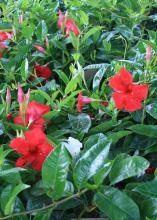Information Possibly Outdated
The information presented on this page was originally released on April 9, 2012. It may not be outdated, but please search our site for more current information. If you plan to quote or reference this information in a publication, please check with the Extension specialist or author before proceeding.
Mandevilla vines give gardening possibilities
If you’re thinking about what you want your porch or deck to look like this summer, consider how you can use Mandevilla, a vining plant best known for its showy displays of summertime flowers.
You can find these plants in red, pink and white at garden centers. Flowers are displayed against a backdrop of dark green, leathery foliage. Leaves can be quite large -- up to 8 inches long. Some selections have smaller leaves. The plants are sometimes sold as Dipladenia, which rhymes with gardenia.
Flowering begins in the early summer and continues through frost in the fall. Mandevilla is considered a tender plant that requires protection when temperatures fall below 40 degrees. This plant is hardy through zone 9, which is good news in the coastal counties.
Mandevilla is usually killed back by fall frosts, but it may grow back from the root system the following spring. Most gardeners simply treat Mandevilla as a flowering annual.
Mandevilla grows and flowers best when planted in full sun. It will tolerate partial shade in hot locations, such as south-facing walls. Make sure the soil in the planting bed is rich with organic matter to assure good drainage, but don’t let the soil dry out too much. Mandevilla can tolerate some droughty conditions, but it requires supplemental irrigation for extended periods of drought.
Mandevilla is a great choice for growing in containers on the porch or patio. This is a popular planting method in areas with cold winters. When the cold winds start to blow, gardeners simply bring the container inside for protection. If it is placed in a window with enough light, the Mandevilla makes a fine houseplant for the winter months.
Because Mandevilla is a vining plant, you must provide support for the plant to scramble and climb. You can make your own supports from hardware cloth, plastic mesh or other materials that give the plants a surface to scramble on. You can hang the mesh between two stakes for a simple design.
If you want something more elaborate, you can design a trellis from thin strips of wood secured in a vertical and horizontal crisscross pattern. If you don’t provide support, Mandevilla could be considered an odd choice for a ground cover.
Mandevilla is very tolerant to pruning. With careful pruning, you can train the plant to grow in a shrub-like form. Flowers are produced on new growth, so there is little worry about pruning too much and removing the season’s blooms.
Mandevilla is a fast-flowering vine that can quickly cover a garden with beautiful, colorful flowers or mask an ugly area in your landscape.








